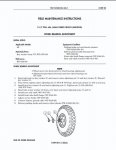superchicken
New member
- 2
- 0
- 0
- Location
- Madison In.
I am currently involved in a complete brake overhaul on my 73 M35A2. I have looked on line for TM9-2320-209-20-3-2 and haven't found this manual. The question I am asking is what is the preload torque spec for the hub bearings on the rear hubs. Would also appreciate the front torque spec on the front bearings for the hubs



